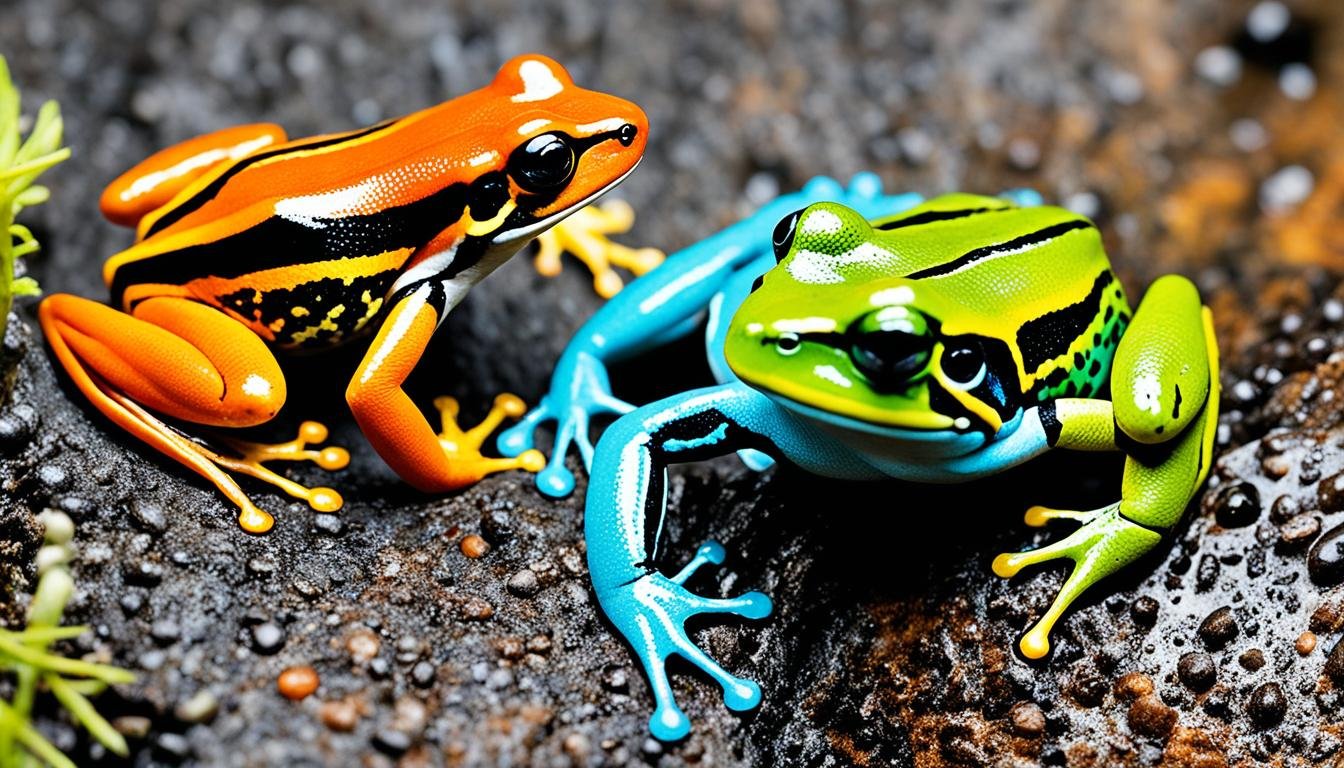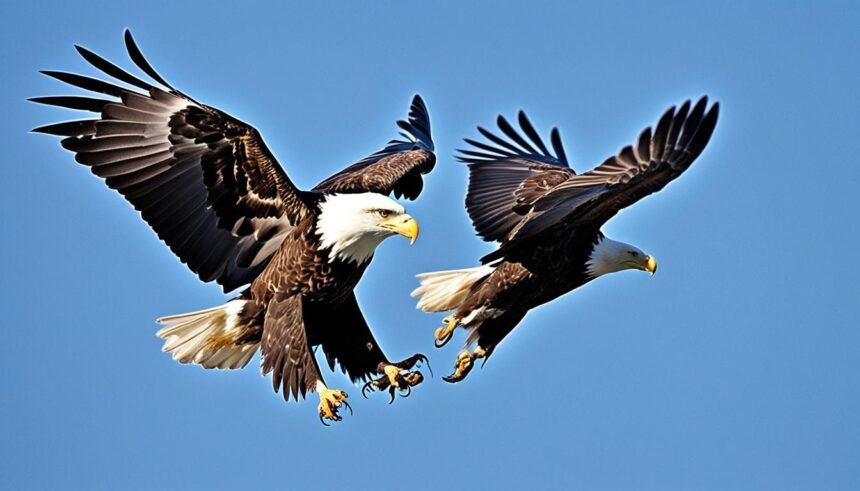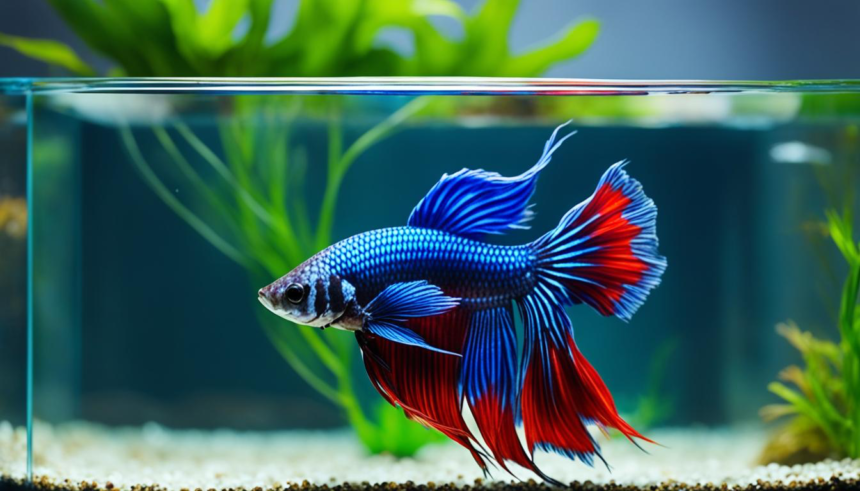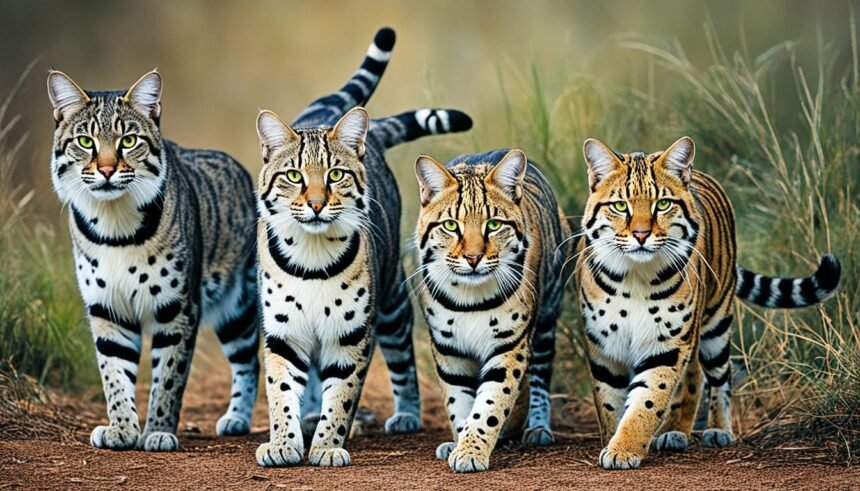Amphibians are a fascinating group of animals loved by nature fans. There are about 8,000 amphibian species in the world. They vary a lot in how they look, where they live, and their life stages. You can find frogs, salamanders, and caecilians as the main types in the top animal amphibian list.
Frogs are found nearly everywhere and make up most amphibian species. They live in places like rainforests and deserts. These creatures start as tadpoles, living in water, and later become frogs that can live on land. Some famous frogs are the colorful poison dart frogs, the red-eyed tree frog, and the huge goliath frog.
Salamanders and newts are part of the Caudata order. They’re like long, wet lizards and can grow back parts of their body. The giant Chinese salamander is the world’s biggest. It can be as long as 1.8 meters.Other interesting salamanders are the axolotl and the mudpuppy.
Caecilians are the most secretive amphibians and look like long snakes. They live in the tropics and don’t have legs. These creatures are expert burrowers and help their ecosystems in many ways.
Amphibians are in danger from many problems like losing their homes and pollution. Nearly half of all amphibians could disappear. Protecting these unique animals and their homes is very important.
Introduction to Amphibians
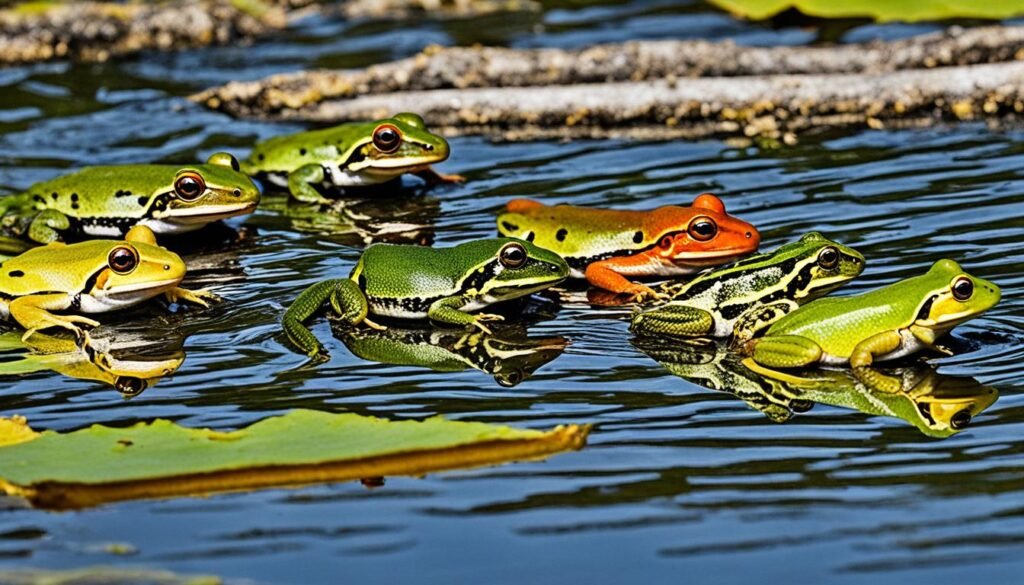
Amphibians are a cool group of animals without warm blood that fit in the class Amphibia. They have special traits and can live in lots of places. There are about 8,100 different kinds of amphibians. This shows how varied they are.
What Are Amphibians?
These animals don’t make their own heat, so they need other things to stay warm or cool. They have soft, wet skin without scales. This skin has special parts that can make poisons for protection.
Amphibians take in air and water through their skin. This makes it easy for them to live both on the ground and in the water. They’re very key in keeping our land and water habitats strong.
Characteristics of Amphibians
One unique thing about them is their life change, from a baby form to an adult, called metamorphosis. For instance, they might start as things like tadpoles and then change into frogs. They also have a heart with three parts, not as good at moving blood to their body as birds and mammals are.
They’ve adapted well to many places, from the warm, wet rainforests to cooler forests.
The Three Orders of Amphibians
Amphibians fit into three groups: Anura, Caudata, and Gymnophiona. Frogs and toads are in Anura, the group with the most species, about 6,500. Caudata, which includes salamanders and newts, has around 680. Apoda, Gymnophiona, the group with limbless caecilians, has roughly 200 species.
| Order | Common Name | Number of Species | Distinguishing Features |
|---|---|---|---|
| Anura | Frogs and Toads | ~6,500 | Tailless, powerful hind limbs for jumping |
| Caudata (Urodela) | Newts and Salamanders | ~680 | Tails and two pairs of limbs |
| Gymnophiona (Apoda) | Caecilians | ~200 | Limbless, worm-like, adapted for burrowing |
Amphibians are super important in their homes as both food and predators. They eat lots of insects and are meals for other animals like birds, reptiles, and mammals. When there are many amphibians in an area, it often indicates a clean, healthy place. They react quickly to pollution and bad changes in their environment.
Frogs: The Most Diverse Amphibian Order
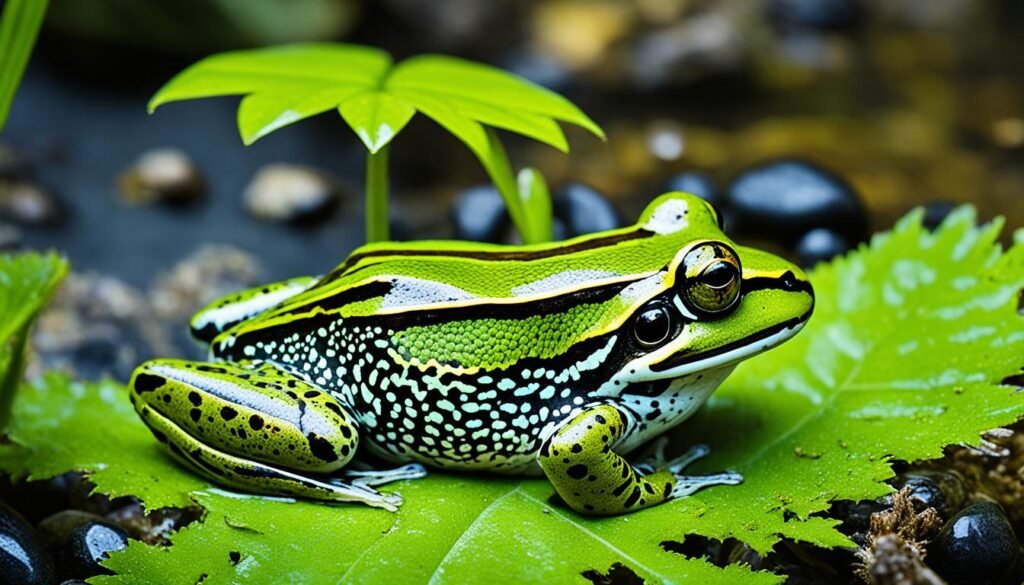
Frogs belong to the order Anura. They are the most diverse amphibians, with over 7,000 species. They live in many places, from tropical forests to desert dunes. Frogs are found on all continents except Antarctica. Their variety shows how well they adapt and survive in different places.
Unique Features of Frogs
Frogs have special features not found in other amphibians. Their back legs are strong, helping them jump far. They also have big eyes for seeing well. A frog’s tongue is sticky and can grab insects very quickly. This skill makes them great hunters, eating bugs, worms, and other small creatures.
Life Cycle of Frogs
Frogs go through interesting changes in their life cycle. They start as eggs in water, then hatch into tadpoles. Tadpoles breathe through gills and are fully aquatic. As they grow, they develop into adult frogs. They get lungs, lose their tails, and grow legs. This change allows them to live near or in the water.
Notable Frog Species
Several frog species are quite unique. The goliath frog is the world’s biggest frog. It can grow up to 1.1 feet long. On the other hand, the Paedophryne amauensis is the smallest frog. It averages just 0.3 inch long. It’s the world’s tiniest vertebrate.
Poison dart frogs have bright colors to let others know they are dangerous. The red-eyed tree frog looks extraordinary and can glide from tree to tree. The wood frog is amazing too. It can survive winter by freezing. This protects its body until it thaws out.
| Frog Species | Notable Characteristic | Native Region |
|---|---|---|
| Goliath Frog (Conraua goliath) | Largest known frog species | Cameroon and Equatorial Guinea |
| Paedophryne amauensis | Smallest known frog and vertebrate | Papua New Guinea |
| Poison Dart Frogs (Dendrobatidae) | Brightly colored and toxic | Central and South America |
| Red-Eyed Tree Frog (Agalychnis callidryas) | Striking appearance and gliding ability | Central America |
| Wood Frog (Lithobates sylvaticus) | Able to survive being frozen | North America |
There are over 7,000 frog species, showing their adaptability and success. Different frogs, like the very small Paedophryne and the very large goliath frog, inspire scientists and nature lovers. We’re always finding new frog species. This adds to the excitement of studying these interesting animals.
Salamanders: The Second-Largest Amphibian Order

Salamanders are part of the Caudata order, after frogs and toads, with over 740 species. They are identified by their long bodies, tails, and limbs. Salamanders live in varied places like water bodies, forests, and caves, where some hunt while others are hunted.
The largest amphibian is the Chinese giant salamander. It grows to about 1.8 meters long and weighs 50 kg. Sadly, this giant is at risk due to losing its home, pollution, and being caught. It eats many things, including bugs, fish, and even other salamanders.
The axolotl from Mexico is also quite famous. It remains looking like a baby throughout life, known as neoteny. Even more amazing, it can grow back lost body parts.
The hellbender comes from the U.S. and lives entirely in water. It looks wrinkled and flat. These salamanders are up to 74 cm long. Their presence is a sign that the water they live in is clean.
| Species | Maximum Length | Distribution |
|---|---|---|
| Chinese giant salamander (Andrias davidianus) | 1.8 m (5.9 ft) | China |
| Japanese giant salamander (Andrias japonicus) | 1.44 m (4.7 ft) | Japan |
| Hellbender (Cryptobranchus alleganiensis) | 74 cm (29 in) | Eastern United States |
| Mudpuppy (Necturus maculosus) | 43 cm (17 in) | Eastern United States, southeastern Canada |
Some salamanders lay eggs in water while others give birth to live young. Many of them have special ways of showing they like each other. For instance, male Chinese giant salamanders watch over their eggs.
But these amazing creatures are in danger from people’s actions. Focusing on protecting them is very important. We want them to stay on earth for many more years to come.
Caecilians: The Least-Known Amphibian Order
Caecilians are a unique type of amphibian. They belong to the order Gymnophiona. They are the least-known group of living amphibians. There are about 200 known species. These creatures are often confused for snakes or worms because they don’t have limbs.
They have long, segmented bodies. Caecilians have unique adaptations. They are one of the three groups of living amphibians, alongside frogs and salamanders.
Caecilians are easily mistaken for snakes or worms. This is because they have long, segmented bodies. They are limbless, which adds to the confusion.
Caecilians’ bodies look like they’re made of rings. This gives them a worm-like look. They also don’t have arms or legs.
They have something special on their heads. It’s a sensory tentacle. This helps them move around and find food.
Caecilians have a special type of skull that makes it easier for them to burrow. Their eyes are small. They usually rely on other senses to find their way.
These special creatures have a lot of vertebrae. They have more than any other type of amphibian. They can have between 95 and 285 presacral vertebrae.
They also have more than 200 lymph hearts. These are under their skin. They help keep their blood flowing well.
| Family | Number of Species | Number of Genera |
|---|---|---|
| Caecilidae | 123 | 21 |
| Ichthyophiidae | 50 | 3 |
Habitat and Distribution of Caecilians
Caecilians live in warm places around the world. This includes parts of South America, Africa, and Asia. They like places such as forests and grasslands. Many caecilians live underground. They eat small creatures like earthworms.
Some caecilians like living in water. For example, the Typhlonectes species is totally aquatic. It lives in rivers and streams.
In India’s Western Ghats, you can find a special type of caecilian. It’s called the yellow-striped caecilian or Ichthyophis beddomei. It has bright yellow stripes on its body. These stripes stand out against its dark skin.
Like other caecilians, this one helps keep its home healthy. It does this by digging in the soil and eating small animals.
There is still a lot to learn about caecilians. This is because their history and body are not easy to study. But, scientists are working hard to learn more. They are finding out about their unique ways of living.
Amphibian Habitats and Distribution
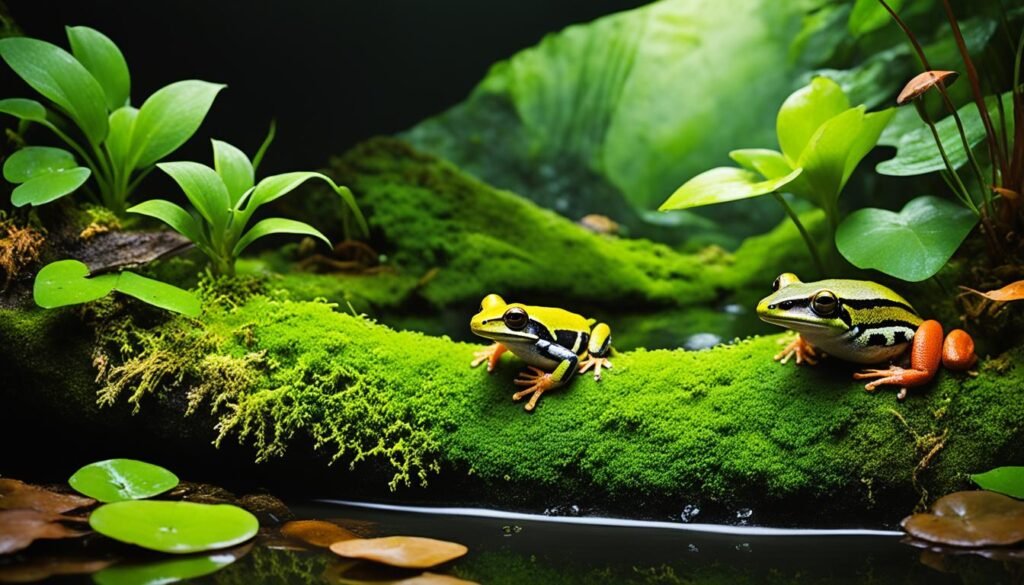
Amphibians live in many places. They range from rainforests to deserts and live on every continent except Antarctica. They are cold-blooded animals. Their skin lets them take in water and air.
Moisture is key for amphibians. They breathe and drink through their skin. This makes them very sensitive to dry places.
Aquatic Amphibians
Some amphibians are always in water. They live in places like streams, rivers, and ponds. These animals are well-suited for water life. They have sleek bodies and special body parts for swimming.
Some examples of water-dwelling amphibians are:
- African clawed frog (Xenopus laevis)
- Axolotl (Ambystoma mexicanum)
- Hellbender (Cryptobranchus alleganiensis)
- Chinese giant salamander (Andrias davidianus)
Terrestrial Amphibians
Other amphibians prefer the land. They still need moist places. These include those with sticky feet and others that are poisonous. Such adaptations help them live on both land and in water.
There are many famous land amphibians. Some are listed here:
- Red-eyed tree frog (Agalychnis callidryas)
- Poison dart frogs (Dendrobatidae family)
- Fire salamander (Salamandra salamandra)
- American toad (Anaxyrus americanus)
Amphibians in Different Climates
Amphibians can live in a variety of climates. This includes both hot and cold places. Yet, they need the right homes and weather. In the United States alone, many species can be found in different areas.
| Region | Number of Species | Notable Species |
|---|---|---|
| Continental U.S. | Approximately 460 | American bullfrog, spotted salamander |
| Sonoran Desert | Around 100 reptiles, at least 20 amphibians | Sonoran Desert toad, canyon treefrog |
| Chihuahuan Desert | Over 170 herpetofauna, at least 18 endemic | Chiricahua leopard frog, western spadefoot |
| Southern Colorado Plateau Network | At least 58 herpetofauna | Jemez Mountain salamander, northern leopard frog |
| Saguaro National Park | 56 native reptiles and amphibians | Sonoran Desert toad, Gila monster |
Ampibians are threatened by many things. These include: losing their homes, pollution, and climate change. Humans and other animals that don’t belong can also harm them. We must work to protect amphibians and their environments.
Amphibian Adaptations

Amphibians have adapted in amazing ways to survive both on land and in water. Take the hellbender, for instance, North America’s big salamander that can reach over two feet. It needs clean, cool rivers to live, since it breathes through its skin. Hellbenders are pretty good at hiding and have evolved to match the look of rocks in their homes, keeping away from predators.
Hellbenders are uniquely built for their watery homes. They have extra skin that helps them absorb more oxygen from water. This feature lets them live in places where oxygen levels may change. They also have an amazing sense of smell, which helps them with several things. They use it to sense danger, find food, and look for a mate. Their mouths work like vacuums, making eating easy, and their tails help them swim fast to escape danger.
One cool thing about hellbenders is how they can make slime. This slime helps them against predators and keeps diseases away. But, they can get sick easily if their water has pollutants, because their skin easily absorbs them. This is a big problem because hellbenders, along with other amphibians, are facing population drops due to human impacts on their homes.
Amphibians, including hellbenders, are important in showing us how healthy our water homes are. Scientists watch them and their surroundings to understand what changes might be happening in the environment. Learning about them helps us protect their homes better. Saving their living spaces and keeping the water clean are key to their survival. If you want to know more about hellbenders and how to help them, check out this guide from Purdue University Extension.
| Adaptation | Function |
|---|---|
| Camouflage | Blending in with gravel and cobble rocks for defense |
| Skin folds on sides | Increasing surface area for oxygen absorption |
| Keen sense of smell | Detecting predators, prey, and mates |
| Vacuum-like mouth | Swallowing prey whole |
| Paddle-shaped tail | Escaping from threats |
| Slime production | Defense against predators and pathogens |
Amphibians in Ecosystems
Amphibians such as frogs, salamanders, and caecilians are key in their habitats. They transform from water creatures to land dwellers in their lifetimes. They live in many places, from rainforests to colder zones, helping keep their homes in harmony.
Amphibians as Prey
Amphibians are vital food for many animals. Birds, reptiles, and other frogs eat them. Their young, like tadpoles, are food for fish and insects. They pass energy up the food chain.
Amphibians as Predators
Amphibians eat insects too. They help keep bug populations in check. A frog may eat hundreds of bugs in one night. Some, like the cane toad, can hurt local species when brought to new places.
| Amphibian Order | Number of Species | Examples of Predatory Behavior |
|---|---|---|
| Anura (Frogs and Toads) | 7,243 | Consume insects, spiders, and other small invertebrates |
| Caudata (Salamanders and Newts) | 759 | Feed on insects, worms, and small aquatic animals |
| Gymnophiona (Caecilians) | 214 | Prey on earthworms, termites, and other soil invertebrates |
Amphibians as Indicators of Ecosystem Health
Their thin skin makes amphibians very sensitive to their environment. They’re the first to feel the effects of pollution. A drop in their numbers shows something’s wrong with their home, like pollution or loss of space.
In short, amphibians are very important for their homes. They both eat and are food for others. They tell us when the environment is in trouble, acting as warning signs for bigger problems.
Threats to Amphibians
Amphibians are in deep trouble, with many at risk of dying out. The International Union for Conservation of Nature (IUCN) says 41% of amphibians are in danger. This is up from 39% in 2004. The main danger is from losing their homes because of human actions, pollution, and changes in the weather. Invasive species and diseases also hurt them.
Habitat Loss and Fragmentation
Losing and damaging their homes is a big risk for amphibians. It causes their numbers to drop and can make certain types disappear locally. Places like wetlands, important for breeding, are being lost. This makes amphibians stay in smaller areas which can then vanish. People building cities and farms are major reasons for this loss. Areas under heavy threat include the Caribbean, the tropical Andes, Madagascar, and Sri Lanka.
Pollution and Contaminants
Amphibians can easily absorb toxic chemicals through their skin. These poisons can lead to birth defects, less babies being born, and death. Places with lots of farms or nearby cities are dangerous for them.
Climate Change
The changing climate messes up amphibians’ lives by altering their homes and breeding times. They rely a lot on what’s happening in their environment. More extreme weather could lead to drying breeding spaces and loss of homes.
Invasive Species
Invaders like the American bullfrog and the African clawed frog are bad news for locals. They eat the food of local frogs and can bring diseases. Putting fish that eat amphibians into their homes is another big challenge for them.
Disease
New diseases are a big reason why amphibians are dying out. A fungus known as chytrid is a big problem. A type of virus called ranavirus is also killing many of them, especially the young ones.
| Threat | Impact on Amphibians |
|---|---|
| Habitat Loss | Declines in population levels and species diversity |
| Pollution | Deformities, reproductive issues, and mortality |
| Climate Change | Disruption of breeding cycles and shifts in ranges |
| Invasive Species | Competition for resources, predation, and disease introduction |
| Disease | Population declines and species extinctions |
We need to act fast to save amphibians. Protecting their habitat, stopping pollution, and slowing down climate change are key. So is fighting off invasive species and diseases. Everyone’s help is needed to keep these unique animals alive for the future.
Animal Amphibian List
Amphibians have around 8,000 species. They belong to three main groups: Anura (frogs and toads), Caudata (salamanders and newts), and Gymnophiona (caecilians). This list of amphibians shows popular species from each group. It talks about what makes them special.
Frogs and Toads
Frogs and toads are the biggest group, with almost 90% of all amphibians. Some well-known ones are:
- African Bullfrog: Lives in southern Africa, eats insects, small animals, and other frogs.
- American Bullfrog: Found in North America, known for its loud ‘bull-like’ calls.
- Cane Toad: From Central and South America, harmful in Australia where it was introduced.
- Common Toad: Lives in Europe, very common and known for its warts.
- Poison Dart Frogs: Colorful and toxic, found in Central and South America.
- Red-Eyed Tree Frog: Colorful with big red eyes, lives in Central America.
- Tomato Frog: Bright red, from Madagascar, secretes sticky substance when scared.
- White-Lipped Tree Frog: Australian and New Guinean, changes color, has white lips.
Salamanders and Newts
Salamanders and newts come next, with over 800 species. Here are some famous ones:
- Axolotl: Lives in Mexico, fully aquatic, critically endangered.
- Chinese Giant Salamander: The largest, found in China, critically endangered.
- Common Mudpuppy: From North America, entirely aquatic, eats small creatures.
- European Fire Salamander: Bright black and yellow, lives in Europe.
- Hellbender: An indicator of water health, looks old, from North America.
Caecilians
Caecilians are the least known with about 200 types. They look like worms and live in the tropics. Some interesting ones are:
- Beddome’s Caecilian: From India, known for its yellow stripes.
- Yellow-Striped Caecilian: South American, has bright yellow stripes, can grow to 1.5 meters.
| Amphibian Order | Number of Species | Notable Species |
|---|---|---|
| Anura (Frogs and Toads) | Around 7,200 | African Bullfrog, American Bullfrog, Cane Toad, Poison Dart Frogs, Red-Eyed Tree Frog |
| Caudata (Salamanders and Newts) | Over 800 | Axolotl, Chinese Giant Salamander, Common Mudpuppy, European Fire Salamander, Hellbender |
| Gymnophiona (Caecilians) | Around 200 | Beddome’s Caecilian, Yellow-Striped Caecilian |
Conclusion
Frogs can be as small as your fingertip like the Paedophryne amauensis. They can also grow to be almost as long as two people lying head to foot, just like the South China giant salamander. There are about 8,100 types of amphibians known to us today. They live in places as different as wet rainforests and dry deserts.
Modern amphibians come in three main groups: Anura for frogs and toads, Caudata for newts and salamanders, and Gymnophiona for caecilians. Each group has its own special features. This is what makes them unique from one another.
When it comes to making babies, amphibians have many cool ways to do it. Some lay eggs in water that turn into tadpoles. Others have babies by keeping the eggs safe on their own bodies or even inside mommy frogs. Amphibians are the best at coming up with ways to have kids that are different from all other animals.
Unfortunately, amphibians have a lot of problems to deal with right now. Their homes are disappearing, and the water and air around them is getting dirtier. They also have to fight against new animals invading their spaces. Diseases, like the chytrid fungus, are making things even harder for them.
We must learn more and care for amphibians for the good of our Earth. It’s very important that we protect their homes. If we clean up the environment and help stop climate change, we can make their future brighter. Taking care of amphibians also means taking care of our home. By protecting them, we protect ourselves in the long run.
FAQ
What are the three orders of amphibians?
The three orders of amphibians include frogs (Anura), salamanders (Caudata), and caecilians (Gymnophiona).
How many known amphibian species are there?
Currently, scientists know of about 8,000 amphibian species. Most of them, nearly 90%, are frogs.
What are some unique characteristics of amphibians?
Amphibians stand out due to their thin, wet skin without scales. This skin can secrete toxins. They’re also cold-blooded and have a three-chambered heart. Their circulation, however, is not as good as that of mammals or birds.
What is the largest amphibian species?
The Chinese giant salamander takes the title for the largest amphibian. It can grow as long as 1.8 meters (6 feet).
What is the most diverse order of amphibians?
Among amphibians, the frogs are the most diverse. They have over 7,000 identified species.
What are some adaptations that help amphibians survive in their diverse habitats?
Amphibians use several adaptations to survive. They have poisonous skin, sticky toe pads for climbing, and webbed feet for moving through water.
They also have sensory tentacles to find their way in the dark.
Why are amphibians considered excellent indicators of ecosystem health?
Amphibians have skin that allows toxins to pass through. This makes them very sensitive to changes in their environment. Thus, their population changes can warn us of bigger problems like pollution or habitat loss.
What are some threats facing amphibians?
Many issues threaten amphibians, including loss of homes, pollution, climate change, and invasive species. Diseases, especially chytrid fungus, are a serious concern.
What are some notable frog species?
Notable frogs include the red-eyed tree frog, poison dart frogs, and the world’s biggest – the goliath frog. The wood frog can freeze and survive, and the microhylid frogs are among the smallest.
What can we do to help protect amphibians?
We can help amphibians by supporting conservation projects and reducing pollution. Creating suitable habitats and educating others on their importance also makes a big difference.

